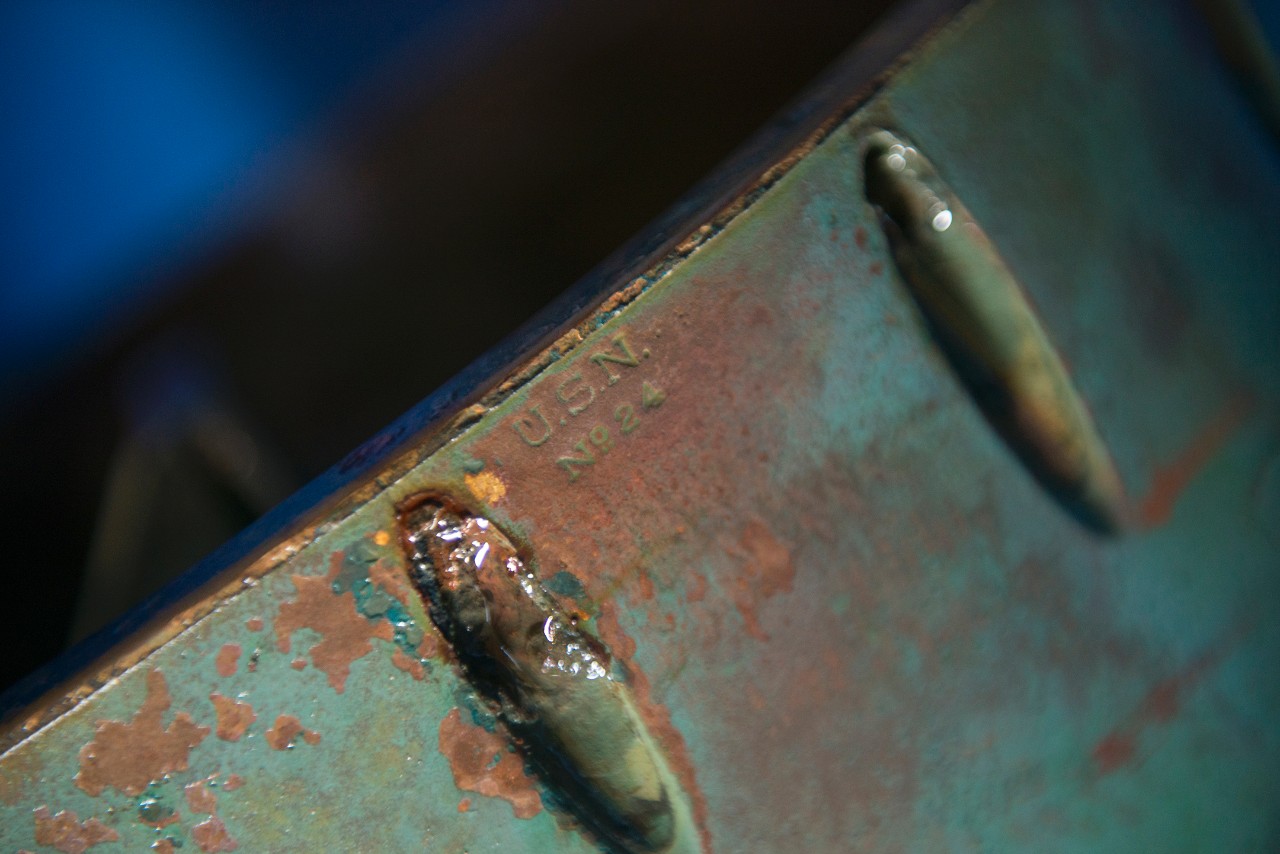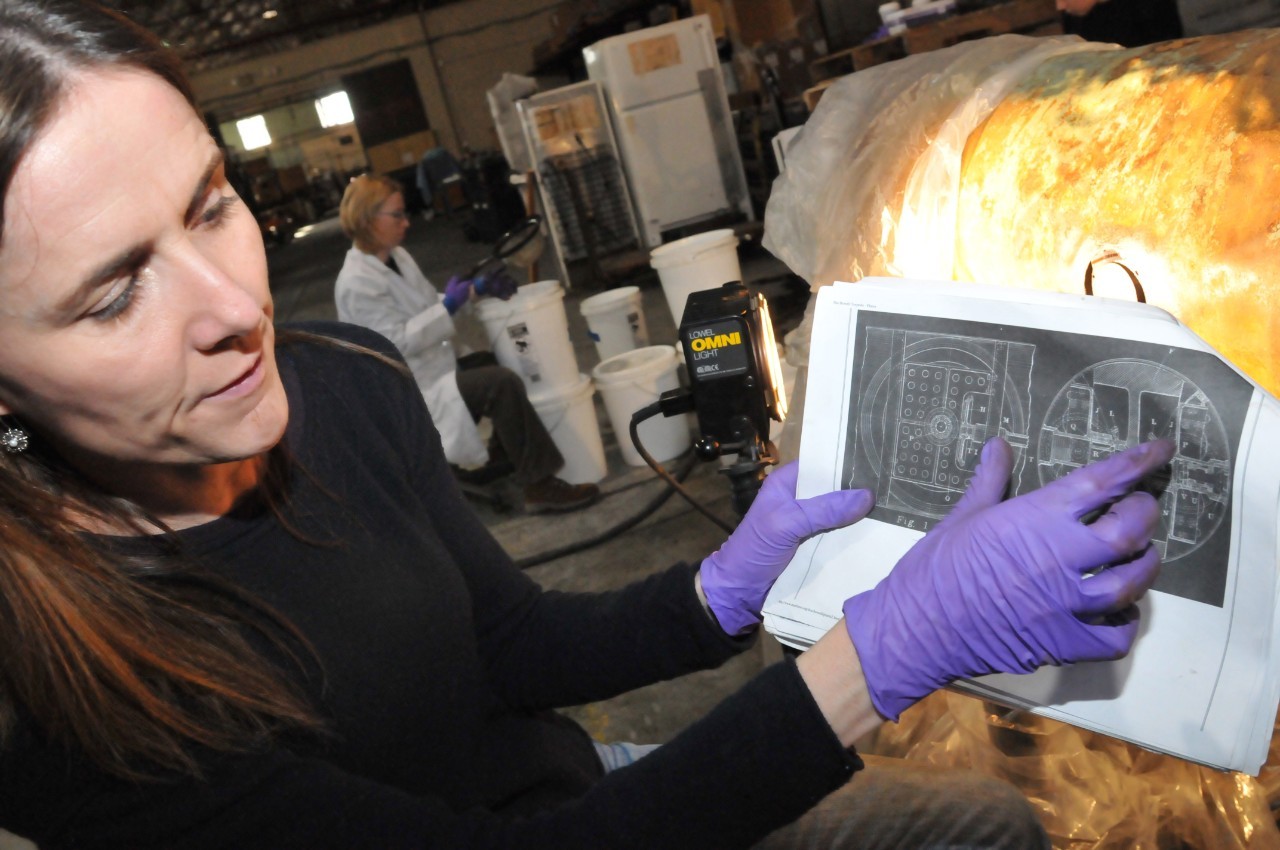
Story Number: NNS140131-21Release Date: 1/31/2014 3:18:00 PM
By Mass Communication Specialist 1st Class Tim Comerford, Naval History and Heritage Command Communication and Outreach Division
WASHINGTON (NNS) -- Naval History and Heritage Command's (NHHC) Underwater Archeology Branch (UAB) and conservationists from Terra Mare Conservation opened the mid-section of the more than a century-old Number 24 Howell Torpedo undergoing conservation at the Washington Navy Yard, Jan. 30.
The torpedo was opened to access its flywheel, a device that is used to store energy and used to propel the torpedo. The conservators opened the torpedo and found the section full of sediment - 141 pounds of it - but they believe there may be some manmade pieces mixed in.
"It's mostly sediment, but we have some bits and pieces that could be some parts like screws," said Paul Mardikian, an experienced conservator with Terra Mare, who is in charge of coming up with the torpedo's conservation plan. "When we opened the bulkhead of the torpedo we had an almost perfect line of sediment showing that this part of the torpedo landed in its original position. It did not tumble or change position. The position of the sediment tells you the exact final resting position of the torpedo. That's very interesting. You can also interpret the material, whether it is sandy or more like silt. You cannot process the final image until you have all the information together. We may use this information later on."
As Mardikian and his fellow conservator Claudia Chemello, worked with the torpedo, Heather Brown, an archeologist with UAB, used a fine mesh strainer to look through the sediment.
"We give the sediment to the archeologists who collect it, weigh it and look at it. Then it will either be kept as part of the records or discarded if there is no information that can be extracted from it," Mardikian said. "For the long run, we keep samples."

"We are sifting the material coming out of the torpedo to make sure that parts that have fallen into the sediment don't get discarded," Brown explained, who seemed happy to get her hands dirty. "This is often the thing you end up doing out in the field, but since the whole torpedo was brought to us, we can do it in our lab. It makes it a lot easier and a lot more comfortable. UAB does not typically do a lot of work like this ourselves. We issue the permits and do more managerial work - we don't do as much on-site, hands-on, archeology. So, this is great! We are excited about this opportunity."
As she sifted through the silt and sand Shawna Daniels, maritime conservator, and Catherine Dick, UAB intern, bagged up, labeled and weighed any metal pieces or larger sediment pieces that may have something within them.
Mardikian says opening up the torpedo isn't just to find out what is inside, it's a necessary part of the conservation process.
"We are learning a lot," Mardikian said. "When you are conserving a complex artifact, there are certain things that really are important. First, you really must understand the material you are dealing with, and second, every part of the artifact needs to be inspected for possible sediment or seawater. You cannot preserve an artifact unless you gain access to all parts of it. If it is locked with seawater and sediment inside it is going to rot. So it is mandatory for us to gain access for long term stability."
Still, Mardikian believes his original estimate of the time for conserving the torpedo still holds.
"The conservation plan for the torpedo is coming together and we are getting ready to finalize the document," he said. "Once we have that, we are good to go to execute the plan. Within less than a year we should be done."
The Howell torpedo, named for Navy Lt. Cmdr. John A. Howell, the primary contributor to the design, was developed between 1870 and 1889. The Howell, the first propelled torpedo, was 11-feet long, made of brass, had a range of 400 yards, a speed of 25 knots, and a warhead filled with 100 pounds of explosives.
The mid and tail sections of this rare torpedo, found by U.S. Navy dolphins off the coast of San Diego last March, make it one of three known to exist in the world. The torpedo was transferred to UAB for desalinization and conservation on the Washington Navy Yard, May 31. That was when they discovered a marking on the torpedo, "U.S.N. No. 24".
Further research led to deck logs that indicated the torpedo was launched from USS Iowa (BB-4) during a training operation in December 1899.
For information on Naval History and Heritage Command's underwater archaeology program, visit http://www.history.navy.mil/branches/nhcorg12.htm.
For more news from Naval History and Heritage Command, visit www.navy.mil/local/navhist/.
Read more stories on the Howell Torpedo here:


